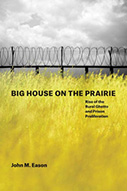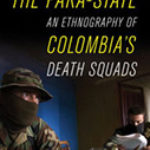BIG HOUSE ON THE PRAIRIE: RISE OF THE RURAL GHETTO AND PRISON PROLIFERATION

Author: John M. Eason
Publisher: Chicago: University of Chicago Press, 2017. 236p.
Reviewer: Larry Bennett | October 2017
In 2007, doctoral candidate John Eason moved his family to the Mississippi Delta to study the community impact of the Forest City Federal Correctional Facility (FCFCF), a prison that had been built in Forrest City, Arkansas in the 1990s. Eason’s ethnographic study focuses not on the prison, its staff, or inmates, but rather, on the small town of Forest City, population approximately 15,000 and the county seat of Arkansas’ St. Francis County. Like so many communities across rural America, the latter decades of the 20th century were unkind to Forrest City. Several major employers closed down or consolidated and relocated their operations; highway-oriented retailers—notably the ubiquitous Walmart—drew customers from downtown, which by the time Eason conducted his research was largely abandoned. In the 1980s Forrest City had become a majority/minority city, and at present whites constitute a little more than one-quarter of the population. The majority group are African Americans, but nearly ten percent of Forrest City residents report their racial identity as Hispanic or mixed. Forrest City is also poor, with an annual median family income of approximately $27,000 and one-third of local residents falling below the federally defined poverty line.
Eason emphasizes that beyond these familiar enough economic patterns and demographic signposts, Forrest City had also become “stigmatized,” a community that both outsiders and many locals viewed as “filthy.” There were two sources of Forrest City’s stigma: a nasty labor action in the 1980s during which workers not only walked out of a foreign-run production facility, but in various ways seemed to demean its Asian owners; almost coincidentally, a sequence of horrific events set in motion by a violent sexual assault. In the wake of “…the worst eighteen-month stretch that any small town could [have] ever had,” Forrest City leadership mounted a campaign to bring a prison to their community. The irony is not lost on Eason, who characterizes the campaign to bring a prison to Forest City as a stigmatized place’s striving to suppress its stigma by attracting a stigmatized institution. Indeed, the heart of this book is an explanation of how a local “growth coalition” mounted a biracial effort to influence state and federal officials to bring the FCFCF to Forrest City, and in turn, an analysis of the impact of the FCFCF.
Eason’s research is, in part, a response to a journalistic and academic literature proposing that there is a “prison industrial complex” of politicians, criminal justice professionals, and private prison builders “that encourage increased spending on imprisonment, regardless of the actual need.” The most compelling sections of Eason’s book trace a process of elite brainstorming, mobilization of local opinion leaders (across Forrest City’s racial divide), and outreach to state and federal officials that—after several years of groundwork—yielded the U.S. Bureau of Prisons’ decision to build in Forrest City. Eason does not argue there is no prison industrial complex. Rather, while acknowledging the interrelated political, economic, and cultural factors driving the United States’ remarkable rate of criminal incarceration, he demonstrates that at least in this economically wasting small town, local interests wholeheartedly and nearly universally sought the local siting of a federal prison.
Eason’s chapters otherwise explore a variety of Forrest City subjects: the ambiance of downtown retail establishments (which in some cases truly are filthy), the tribulations of a middle-class African-American family seeking decent rental housing in Forrest City, the attitudes of both rank and file and “race leader” African Americans toward Forrest City’s white leadership. One of the shortcomings of Eason’s overall conceptualization and execution is a looseness in bringing together the bits and pieces of his ethnography with these larger conceptual points. For example, to open Chapter 7—in the portion of the book devoted to the FCFCF’s impacts—Eason introduces the idea of the institutional actor, the organization such as university, major employer, or in this instance, federal prison, whose program and day-to-day actions can variously uplift or undermine a host community. Across this chapter Eason seems to lose track of this organizing idea—exploring those dirty retail establishments, noting that Forrest City is a food desert—which, after the first couple of pages, never reappears. Curiously, one of the primary insights of the preceding Chapter 6 is that the shifting approaches to the community adopted by a series of FCFCF wardens have made a great deal of difference in community attitudes toward the prison. This would appear to be a telling instance of variation in an institutional actor’s behavior, but not once in Chapter 6 does the concept rear its head.
Similarly, though the subtitle of this volume promises to examine the “rise of the rural ghetto,” apart from asserting that there is a clear relationship between neighborhood conditions in places such as inner-city Chicago and Forrest City’s small-town ghetto, Eason does not systematically lay out the nature of this relationship. For instance, has the growth of Forrest City’s poor African-American population been due to natural increase, a continuing flow of blacks from the more rural areas adjoining Forrest City, some combination of the two, or possibly even the leading edge of the great counter-migration “back to the South” that has recently earned the attention of demographers? Eason asserts the homology between urban and rural ghettoes but does not offer a coherent explanation of the deeper structures producing this sociological phenomenon.
Many readers will also be put off by Eason’s prose, invariably cautious and at some points just ponderous. Regarding the latter, consider the concluding portion of the bottom-page paragraph on page 62: “The rural ghetto discursively connects rural and urban racial and spatial inequality and elucidates a community context that results in health disparities, high crime rates, and increased prisoner reentry. It ultimately represents the persistence of American apartheid in the post-Jim Crow South.” And wrapping up the very next paragraph, Eason writes: “The rural ghetto discursively connects rural-urban racial and spatial inequality, ultimately representing the persistence of American apartheid in the post-Jim Crow South.” As to Eason’s overly cautious stance in relation to academic sources and the particulars of his own argument, on page 105 he cites Robert Bullard’s Dumping in Dixie: Race, Class, and Environmental Quality four times in the span of five sentences!
Awkwardness and analytical dead ends aside, Big House on the Prairie does offer a persuasive explanation of why a small town might find the local siting of a correctional facility attractive. More than his Forrest City subjects, John Eason recognizes that the story of Forrest City and its federal prison exists within a larger play of forces: the persistent problem of urban crime (in some places on the rise since he conducted his Forrest City field work); the norm of highly questionable big city police practices; equally questionable criminal prosecution, sentencing, and incarceration policies. But very much like some of his subjects, notably Larry Bryant, Forrest City’s African-American mayor at the time he conducted his research, Eason expresses a deep ambivalence about America’s rural gulag. While the latter is undoubtedly reflective of a social landscape and criminal justice system whose racial biases are deep and multiple, prison building has in some respects been a good thing for Forrest City: propping up the local economy through infrastructure development and an increment of long-term job creation; and surprisingly enough, by boosting community pride.
Larry Bennett is Professor Emeritus of Political Science at DePaul University.


